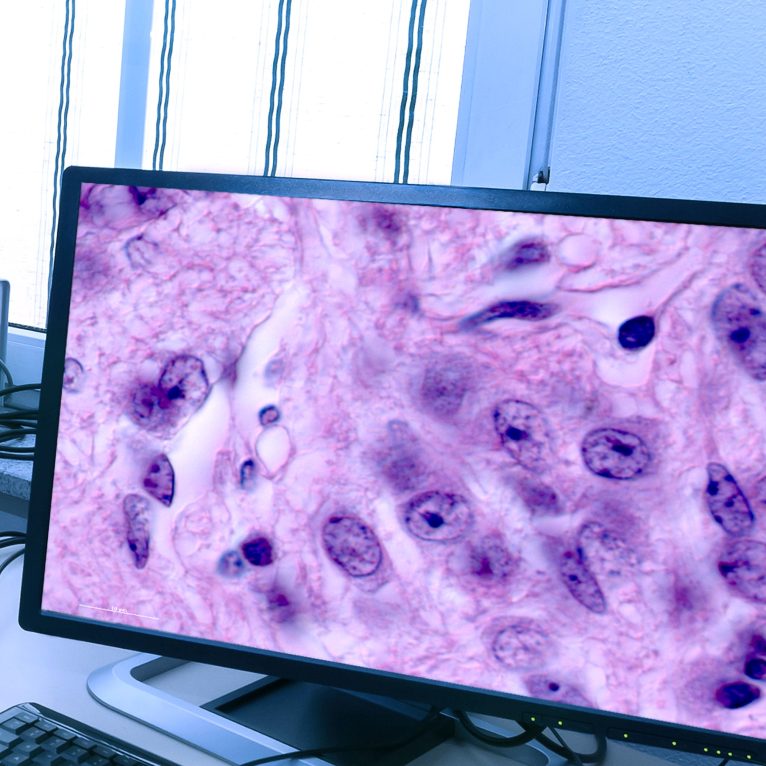
Written by

The clinical digital pathology (DP) market is now taking off, with a flood of new adopters expected over the next few years. Pathology departments face many challenges as they embrace this change, from sequestering additional budgets to altering workflows to accommodate new technologies.
So many changes must be considered with this transition that often there is danger that a ‚Äòfirefight’ can ensue, where stakeholders prioritise their most prominent concerns and leave long-term technical and logistical questions to the wayside.
Take image storage for example; commonly, budget for storage can be an afterthought dictated by how much budget is left over from the implementation process, with departments having to shape their retention strategies around limited storage investment, before further budgetary approval is granted.
This stance is understandable, as not enough examples exist of successful digital pathology implementations today, and identifying the right paths for different labs, which are extremely heterogeneous, often doesn’t have a close prior example for stakeholders to model upon.
Artificial intelligence (AI) is one such area that can often fall to the wayside. Whilst DP AI received much attention back in 2021 when Paige and PathAI raised historic funding rounds, this post-COVID enthusiasm soon gave way to wariness from investors, who saw that the DP AI market had many more challenges than initially thought.
Today, more than 60 vendors are operating in this field, nearly all of which have some form of strategy for short or long-term clinical installation. Despite this, adoption and penetration of the clinical market is still low, with our most recent digital pathology research revealing that the worldwide market for image analysis (not just artificial intelligence) in digital pathology was $104.0M USD in 2022, with around 50% of that attributed to machine learning and more sophisticated algorithms.
As Table 1 shows the trends driving digital pathology AI adoption are very strong, and industry consensus seems to agree that for DP to fully reach its best potential, AI must be embraced.

Table 1: Drivers and Barriers to Digital Pathology AI adoption.
Today, pilot programmes and public trials are publishing favourable results showcasing the benefits in AI adoption, and as the body of evidence in real-world use matures, Signify Research expects that the adoption of multiple algorithm types alongside one another will grow too. How to achieve this in practice is less clear, however.
Every laboratory will be unique in which solutions it may adopt, and there is no one vendor able to tackle 100% of the potential workflow. For this reason, departments increasingly will be driven to adopting solutions from multiple vendors, often tying these into a third-party IMS system. This is when the issue of AI integration, and how well it is achieved, will start to impact pathologists at scale.
Integration for digital pathology sits along a spectrum, with the most advanced algorithms embedded fully into an IMS and able to minimally disrupt a pathologist’s reporting activities. At the other end, pop-up windows which require the pathologist to export results can lead to significant consternation for users, which are already feeling a significant amount of workflow-related burnout.
This is where the concept of an AI orchestration platform, which are already employed within radiology departments, may provide a useful alternative point of reference for pathology.
AI Orchestration Platforms & Potential Benefits
An AI orchestration platform is a platform where different algorithms can be trialled, purchased and integrated easily into a pathologist’s IMS workflow. It can include both open-source algorithms and AI models sold for profit but – crucially offers a unified approach to access. This will allow pathologists to choose AI algorithms which are best suited for them without needing to worry how soon their current IMS will support or be able to integrate a new algorithm.
There are several advantages to employing this type of software:
- Potential to offer direct comparisons between vendor solutions/algorithms: the sheer number of AI vendors and algorithms available today makes it difficult for pathologists identify and compare solutions, and AI orchestration platforms could act as a reference point to directly compare solution features so that pathologists can make informed decisions.
- Could offer independent verification of AI through user studies/reviews: platforms can offer users of each algorithm the ability to submit reviews of each AI, further supporting the pathologists’ decision making.
- Common user interface can be more cost-effective for customers than paying for integration individually: pathology departments, which are already very cost-constrained, may therefore be able to sequester more of their budgets from administrative tasks to innovative products.
- Single point of invoicing and contracting to simplify supply chains: healthcare is moving towards supply chain simplification, and by enabling a more organised approach invoices and contracts can be centralised on the platform, thus further alleviating administrative burdens.
- Can significantly boost route to market for new developers and technologies: by offering new vendors a chance to integrate on a single platform, exposure of newly launched products increases. Such exposure inevitably lends some credibility to potential buyers, and this could lead to innovative approaches/algorithms that may have been overlooked in the past gaining traction much more quickly.
Although disadvantages do also exist, these are primarily routed in the lack of clarity for commercial deployments; limited availability information around price points and profit margins also serves as a warning to prospective third-party developers that platform-listing at scale does not always result in achieving a substantial fee, with anecdotal reporting from radiology suggesting that rarely do AI-platform deals meet the commercial expectations of AI developers. There are however different ways to approach this.
The Spectrum of Service – Radiology’s Lessons
In the radiology AI market, many types of vendors have started to offer these platforms across a spectrum of complexity, with some offering what is essentially an online app store, with little or no support for integration, and others offering end-to-end solutions that address many of the engineering (deployment, workflow integration, etc.) and commercial (contracting, billing, etc.) challenges associated with the distribution and implementation of AI.
Figure 1 outlines the orchestration capabilities and features that these platforms are likely to have with the benefits and prospects of each feature.

Figure 1: showing Features of AI orchestration platforms, and how they can develop to become more sophisticated. Yellow bubbles denote value added to organisations, and the further features are from the centre denotes increasing complexity and sophistication.
The above figure represents a general spectrum of features available in radiology AI orchestration platforms today. Whilst today’s DPAI market is approaching AI deployment from a much more immature position, future development can be shaped by carefully watching the success of each of these vendors.
Of the DP vendors concerned with integrating with AI software in today’s market, the vast majority offer what is essentially an advertisement board, showcasing success and willingness. Very few vendors have been able to make the leap to managing commercial access to algorithms, with many citing a difficulty in providing attractive price points to their customers.
This is because DP AI is also inherently more complex than radiology AI. DPAI vendors must deal with colour and lots more heterogeneity whilst also processing a variety of image standards. This is part of the reason that integration has occurred so slowly, and why we don’t expect the market to leap forward in development anytime soon. However, demand for these types of solutions is expected to grow slowly; Figure 2 below displays how we expect the market to evolve in the near-term.

Figure 2: The market evolution expected by Signify Research for the integration of AI in digital pathology.
Most software IMS focused vendors, such as Philips, Proscia, Sectra, Inspirata, Tribun Healthare, are expected to start rolling out early stages of orchestration software soon (if they haven’t already), with partners for integration/inclusion at first decided by regulatory approvals and customer demand. Providers of AI orchestration platforms will also be restricted by the number of integrations they can offer initially as customers will demand access to a wide range of AI vendors and development efforts for deep integration can be complex. Increasingly, more well-known AI vendors such as Paige and PathAI are also developing their own IMS platforms, although such software is relatively new to the market.
One of the biggest pain points holding the use of radiology AI back today however, is how radiologists interact with and access AI software. Considering the difficult transition pathologists are already expected to make in the next few years, shifting from analogue workflows to digital formats, it would be wise for stakeholders and developers to bear in mind these lessons.
Related Research: Digital Pathology Market Intelligence Service – World – 2023
Signify Research’s Market Intelligence Service provides a rolling 12-month coverage of the global Digital Pathology market. The service is composed of four deliverables, as shown below.

This core market update, the first of four publications included as a part of the service, builds upon five years of previous research, and will enable you to:
- Inform product investment and business strategy
- Evaluate the ever-changing competitive landscape to assess the impact of associations and select potential partners
- Acquire a holistic view of the nuances between different pathology research and clinical markets
- Understand adjacent markets such as enterprise imaging, laboratory information systems and the influence these will have on Digital Pathology
For any further questions, or samples of the service contents, please contact the Imogen Fitt, the report author.
About Imogen Fitt
Imogen joined Signify in 2018 as part of the Healthcare IT team. She holds a 1st class Biomedical Sciences degree from the University of Warwick where her studies included molecular biology and pharmacology. Since joining the team Imogen has studied the medical imaging software and hardware markets and is now expanding Signify Research’s Diagnostics and Lifesciences coverage.
About the Diagnostics and Lifesciences Team
The Diagnostics and Lifesciences team provides market intelligence and detailed insights on the multiple healthcare technology markets where the clinical world intersects with the preclinical. Our areas of coverage include digital pathology, laboratory information systems, clinical Real-World Data (cRWD) platforms, oncology information systems, tumour board software, oncology decision support software and radiotherapy IT. Each report provides a data-centric and global outlook of its markets with granular country-level insights. Our research process blends primary data collected from in-depth interviews with healthcare professionals and technology vendors, to provide a balanced and objective view of the market.
About Signify Research
Signify Research provides healthtech market intelligence powered by data that you can trust. We blend insights collected from in-depth interviews with technology vendors and healthcare professionals with sales data reported to us by leading vendors to provide a complete and balanced view of the market trends. Our coverage areas are Medical Imaging, Clinical Care, Digital Health, Diagnostic and Lifesciences and Healthcare IT.
Clients worldwide rely on direct access to our expert Analysts for their opinions on the latest market trends and developments. Our market analysis reports and subscriptions provide data-driven insights which business leaders use to guide strategic decisions. We also offer custom research services for clients who need information that can’t be obtained from our off-the-shelf research products or who require market intelligence tailored to their specific needs.
More Information
To find out more:
E: enquiries@signifyresearch.net
T: +44 (0) 1234 986111
www.signifyresearch.net

